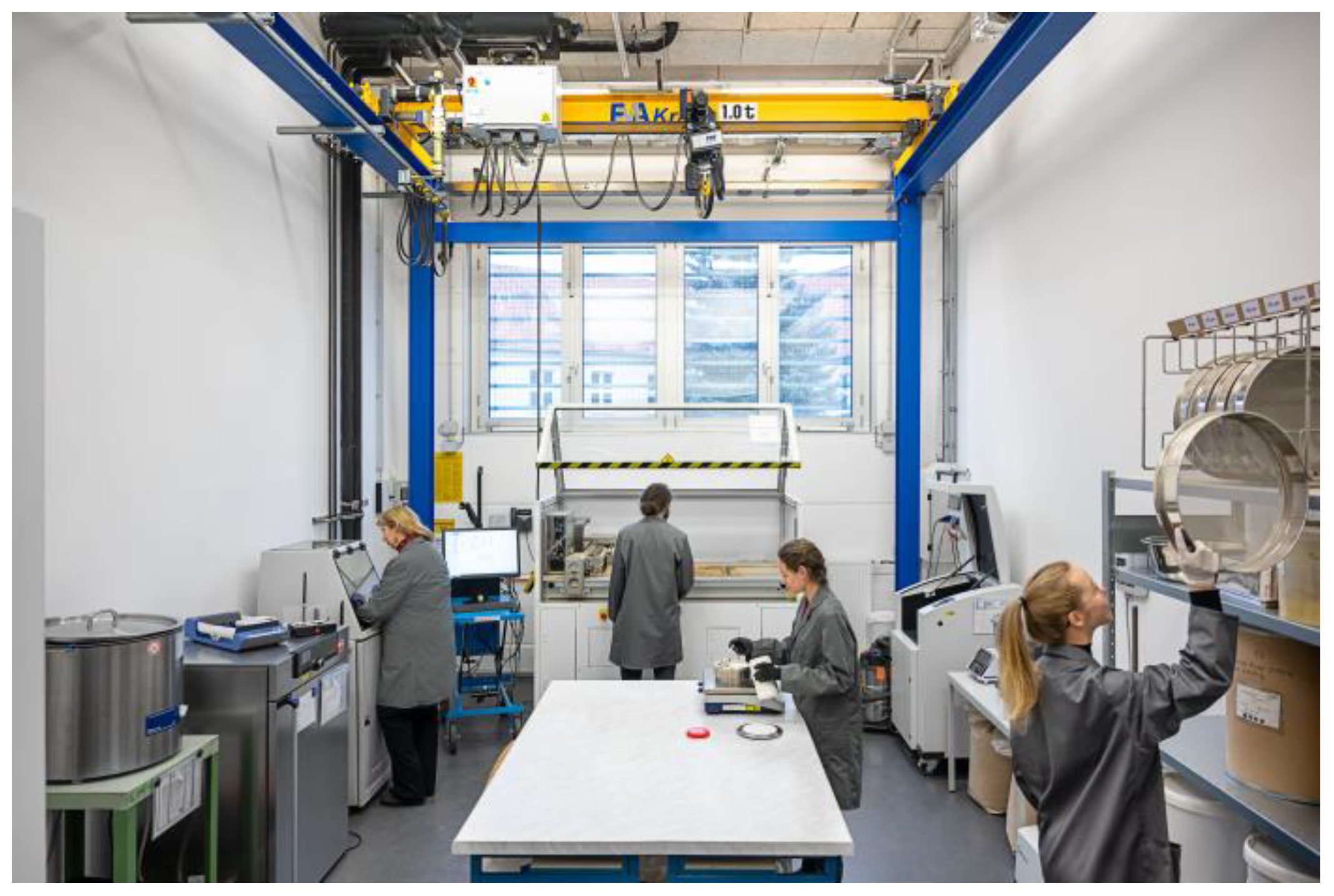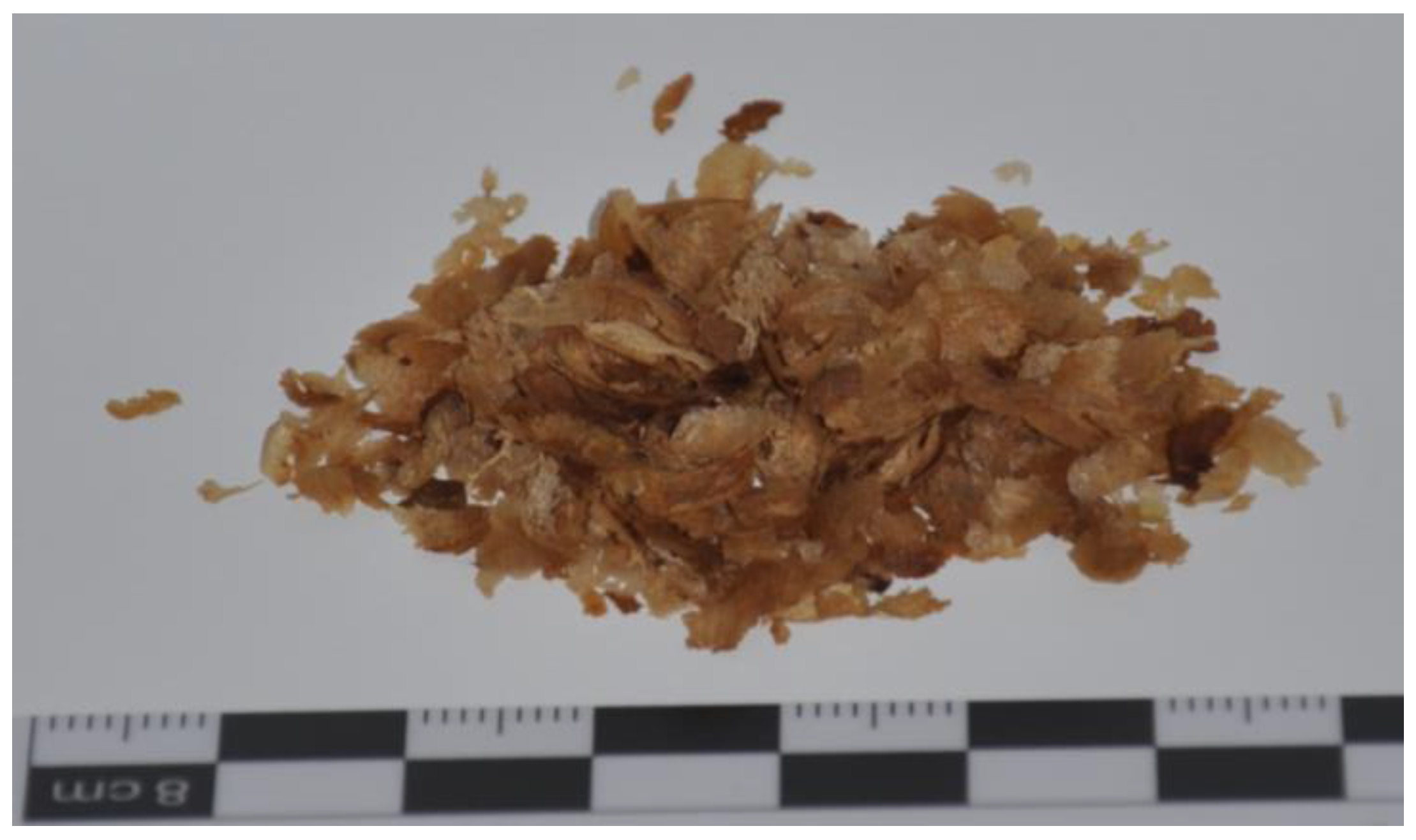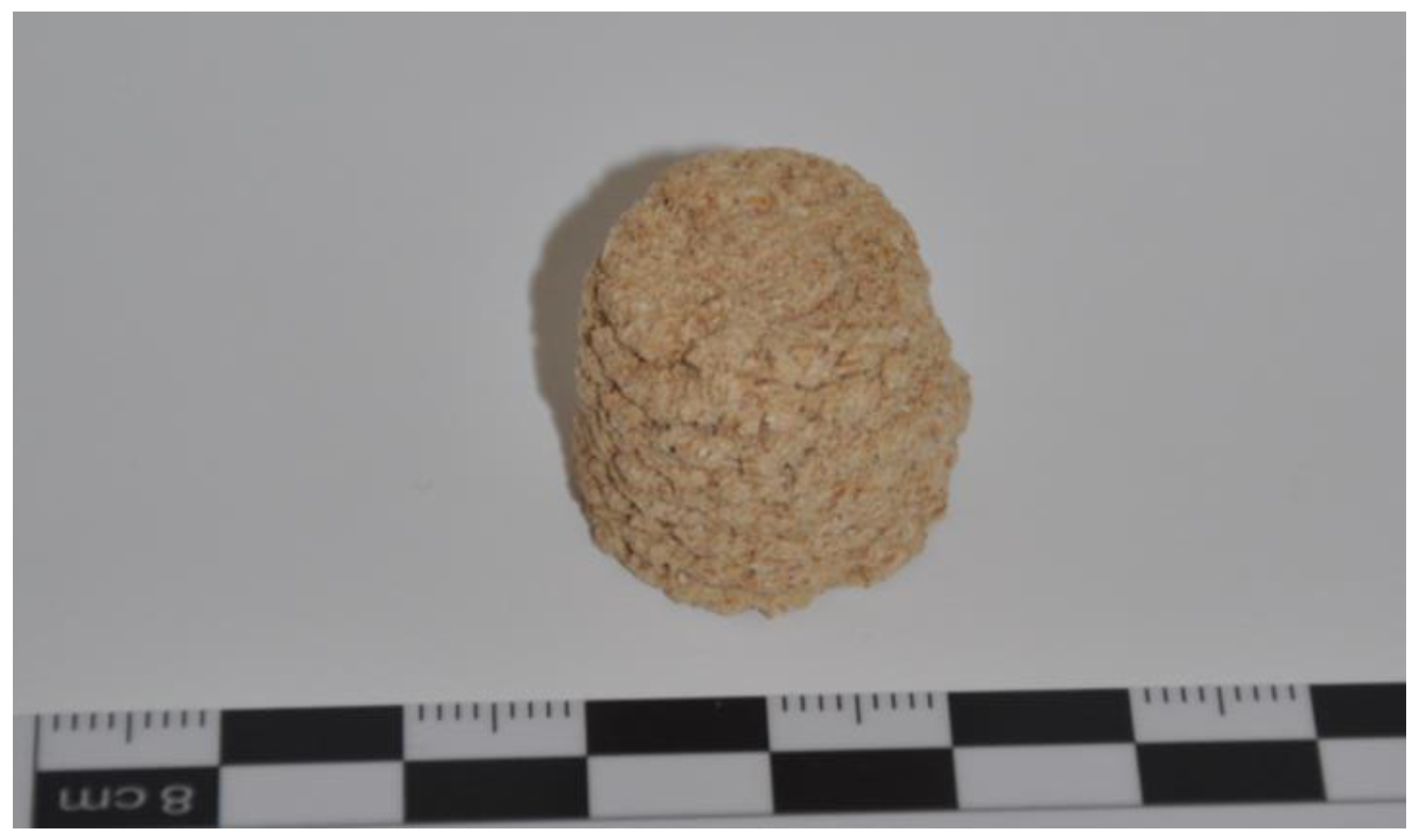SAMSax—An Innovative Living Lab for the Advancement of a Circular Economy through Additive Manufacturing Technologies
Abstract
1. Introduction
2. Additive Manufacturing, Living Labs, and Digitalization of the Circular Economy
2.1. Additive Manufacturing
Additive Manufacturing with Sustainable Materials Based on Residues
2.2. Living Labs
2.3. Digitalization of the Circular Economy
3. Innovation Process
4. Research Status of the SAMSax Living Lab
4.1. Residues for Additive Manufacturing
4.1.1. Differentiation of the Term “Residual Material” from the Term “Waste”
4.1.2. Technological Analysis of Residual Materials
- ABS regenerate;
- Beech and birch wood;
- Carpet residues;
- Chaff straw;
- Coffee husks and coffee grounds;
- Cotton fluff;
- Folding chips;
- Fermentation residues;
- Glass fibers;
- Jeans dust;
- Leather dust;
- Mineral-wood mixtures;
- Miscanthus grass;
- Paper dust;
- Sanding dust;
- Stone residues (mineral chippings, high-grade chippings);
- Waste from grain cleaning;
- Wood from spruce and poplar;
- Wood shavings.
4.1.3. Determination of Residual Material Moisture
4.1.4. Determination of the Particle Size Distribution
4.2. Production-Related Development of Additive Manufacturing
- Preliminary tests with the processed residual materials.
- Prototype parts for partner companies (use case).
- Chaff straw;
- Miscanthus grass.
- Coffee husks;
- Cotton fluff;
- Glass fibers;
- Jeans dust;
- Leather dust;
- Wood from spruce and poplar;
- Beech and birch wood;
- Coffee grounds;
- Paper dust.
4.3. Digitalization
5. Summary and Outlook
Author Contributions
Funding
Institutional Review Board Statement
Informed Consent Statement
Data Availability Statement
Acknowledgments
Conflicts of Interest
References
- Kılkış, Ş. Sustainable Development of Energy, Water and Environment Systems Index for Southeast European Cities. J. Clean. Prod. 2016, 130, 222–234. [Google Scholar] [CrossRef]
- Barbier, E.B. The Evolution of Economic Views on Natural Resource Scarcity. Rev. Environ. Econ. Policy 2021, 15, 24–44. [Google Scholar] [CrossRef]
- Giunta, L.; Hicks, B.; Snider, C.; Gopsill, J. A Living Lab Platform for Testing Additive Manufacturing Agent-Based Manufacturing Strategies. Procedia CIRP 2023, 119, 656–661. [Google Scholar] [CrossRef]
- Pimenov, D.Y.; Mia, M.; Gupta, M.K.; Machado, Á.R.; Pintaude, G.; Unune, D.R.; Khanna, N.; Khan, A.M.; Tomaz, Í.; Wojciechowski, S.; et al. Resource Saving by Optimization and Machining Environments for Sustainable Manufacturing: A Review and Future Prospects. Renew. Sustain. Energy Rev. 2022, 166, 112660. [Google Scholar] [CrossRef]
- Islam, M.T.; Iyer-Raniga, U.; Trewick, S. Recycling Perspectives of Circular Business Models: A Review. Recycling 2022, 7, 79. [Google Scholar] [CrossRef]
- Sudheshwar, A.; Malinverno, N.; Hischier, R.; Nowack, B.; Som, C. The Need for Design-for-Recycling of Paper-Based Printed Electronics—A Prospective Comparison with Printed Circuit Boards. Resour. Conserv. Recycl. 2023, 189, 106757. [Google Scholar] [CrossRef]
- Puerari, E.; De Koning, J.; Von Wirth, T.; Karré, P.; Mulder, I.; Loorbach, D. Co-Creation Dynamics in Urban Living Labs. Sustainability 2018, 10, 1893. [Google Scholar] [CrossRef]
- Voytenko, Y.; McCormick, K.; Evans, J.; Schliwa, G. Urban Living Labs for Sustainability and Low Carbon Cities in Europe: Towards a Research Agenda. J. Clean. Prod. 2016, 123, 45–54. [Google Scholar] [CrossRef]
- Hossain, M.; Leminen, S.; Westerlund, M. A Systematic Review of Living Lab Literature. J. Clean. Prod. 2019, 213, 976–988. [Google Scholar] [CrossRef]
- Leminen, S.; Westerlund, M. Living Labs: From Scattered Initiatives to a Global Movement. Creat. Innov. Manag. 2019, 28, 250–264. [Google Scholar] [CrossRef]
- Bouwma, I.; Wigboldus, S.; Potters, J.; Selnes, T.; Van Rooij, S.; Westerink, J. Sustainability Transitions and the Contribution of Living Labs: A Framework to Assess Collective Capabilities and Contextual Performance. Sustainability 2022, 14, 15628. [Google Scholar] [CrossRef]
- Wirtschaftsstruktur. Available online: https://www.slpb.de/themen/gesellschaft/wirtschaft/wirtschaftsstruktur (accessed on 9 January 2024).
- Colorado, H.A.; Velásquez, E.I.G.; Monteiro, S.N. Sustainability of Additive Manufacturing: The Circular Economy of Materials and Environmental Perspectives. J. Mater. Res. Technol. 2020, 9, 8221–8234. [Google Scholar] [CrossRef]
- Bhatia, A.; Sehgal, A.K. Additive Manufacturing Materials, Methods and Applications: A Review. Mater. Today Proc. 2023, 81, 1060–1067. [Google Scholar] [CrossRef]
- Ngo, T.D.; Kashani, A.; Imbalzano, G.; Nguyen, K.T.Q.; Hui, D. Additive Manufacturing (3D Printing): A Review of Materials, Methods, Applications and Challenges. Compos. Part B Eng. 2018, 143, 172–196. [Google Scholar] [CrossRef]
- Sauerwein, M. Additive Manufacturing for Design in a Circular EconomyMarita; Delft University of Technology: Delft, The Netherlands, 2020. [Google Scholar]
- Huang, S.H.; Liu, P.; Mokasdar, A.; Hou, L. Additive Manufacturing and Its Societal Impact: A Literature Review. Int. J. Adv. Manuf. Technol. 2013, 67, 1191–1203. [Google Scholar] [CrossRef]
- Buhl, J.; Geibler, J.V.; Echternacht, L.; Linder, M. Rebound Effects in Living Labs: Opportunities for Monitoring and Mitigating Re-Spending and Time Use Effects in User Integrated Innovation Design. J. Clean. Prod. 2017, 151, 592–602. [Google Scholar] [CrossRef]
- Engez, A.; Leminen, S.; Aarikka-Stenroos, L. Urban Living Lab as a Circular Economy Ecosystem: Advancing Environmental Sustainability through Economic Value, Material, and Knowledge Flows. Sustainability 2021, 13, 2811. [Google Scholar] [CrossRef]
- Antikainen, M.; Uusitalo, T.; Kivikytö-Reponen, P. Digitalisation as an Enabler of Circular Economy. Procedia CIRP 2018, 73, 45–49. [Google Scholar] [CrossRef]
- Neligan, A.; Baumgartner, R.J.; Geissdoerfer, M.; Schöggl, J. Circular Disruption: Digitalisation as a Driver of Circular Economy Business Models. Bus. Strategy Environ. 2023, 32, 1175–1188. [Google Scholar] [CrossRef]
- Peng, T.; Kellens, K.; Tang, R.; Chen, C.; Chen, G. Sustainability of Additive Manufacturing: An Overview on Its Energy Demand and Environmental Impact. Addit. Manuf. 2018, 21, 694–704. [Google Scholar] [CrossRef]
- Calignano, F.; Mercurio, V. An Overview of the Impact of Additive Manufacturing on Supply Chain, Reshoring, and Sustainability. Clean. Logist. Supply Chain 2023, 7, 100103. [Google Scholar] [CrossRef]
- Ford, S.; Despeisse, M. Additive Manufacturing and Sustainability: An Exploratory Study of the Advantages and Challenges. J. Clean. Prod. 2016, 137, 1573–1587. [Google Scholar] [CrossRef]
- Gebhardt, A.; Hötter, J.-S. Additive Manufacturing: 3D Printing for Prototyping and Manufacturing; Hanser Publications: Munich, Germany; Cincinnati, OH, USA, 2016; ISBN 978-1-56990-582-1. [Google Scholar]
- DIN EN ISO/ASTM 52900:2022-03; Additive Fertigung—Grundlagen—Terminologie (ISO/ASTM 52900:2021). Deutsche Fassung EN_ISO/ASTM 52900:2021. Beuth Verlag GmbH: Berlin, Germany, 2021.
- DIN 8580:2003-09; Fertigungsverfahren—Begriffe, Einteilung. Beuth Verlag GmbH: Berlin, Germany, 2003.
- Popović, A.; Radivojević, V. The Circular Economy: Principles, Strategies and Goals. Econ. Sustain. Dev. 2022, 6, 45–56. [Google Scholar] [CrossRef]
- Jerman, M.; Krinke, S.; Kühnel, L.; Müller, M.; Valentinčič, J.; Zeidler, H. Additive Manufacturing Using Renewable Materials: Concept of Upcycling Peach Kernels for Use in Binder Jetting and FFF. In Proceedings of the Euspen’s 20th International Conference & Exhibition, Geneva, Switzerland, 8–12 June 2020. [Google Scholar]
- Kühnel, L.; Zeidler, H. Characterization and Usability of Powders from Renewable Raw Materials for 3D Printing. In Proceedings of the Euspen’s 20th International Conference, Virtual, 8–12 June 2020. [Google Scholar]
- Zeidler, H.; Klemm, D.; Böttger-Hiller, F.; Fritsch, S.; Le Guen, M.J.; Singamneni, S. 3D Printing of Biodegradable Parts Using Renewable Biobased Materials. Procedia Manuf. 2018, 21, 117–124. [Google Scholar] [CrossRef]
- Singamneni, S.; Behera, M.P.; Le Guen, M.; Zeidler, H. Mechanism of Bonding in Seashell Powder Based Ceramic Composites Used for Binder-Jet 3D Printing. Bioceram. Dev. Appl. 2018, 8, 108. [Google Scholar] [CrossRef]
- Romani, A.; Rognoli, V.; Levi, M. Design, Materials, and Extrusion-Based Additive Manufacturing in Circular Economy Contexts: From Waste to New Products. Sustainability 2021, 13, 7269. [Google Scholar] [CrossRef]
- Romani, A.; Suriano, R.; Levi, M. Biomass Waste Materials through Extrusion-Based Additive Manufacturing: A Systematic Literature Review. J. Clean. Prod. 2023, 386, 135779. [Google Scholar] [CrossRef]
- Rahman, A.M.; Rahman, T.T.; Pei, Z.; Ufodike, C.O.; Lee, J.; Elwany, A. Additive Manufacturing Using Agriculturally Derived Biowastes: A Systematic Literature Review. Bioengineering 2023, 10, 845. [Google Scholar] [CrossRef]
- Krapež Tomec, D.; Kariž, M. Use of Wood in Additive Manufacturing: Review and Future Prospects. Polymers 2022, 14, 1174. [Google Scholar] [CrossRef]
- Cestari, F.; Petretta, M.; Yang, Y.; Motta, A.; Grigolo, B.; Sglavo, V.M. 3D Printing of PCL/Nano-Hydroxyapatite Scaffolds Derived from Biogenic Sources for Bone Tissue Engineering. Sustain. Mater. Technol. 2021, 29, e00318. [Google Scholar] [CrossRef]
- Nida, S.; Moses, J.A.; Anandharamakrishnan, C. 3D Extrusion Printability of Sugarcane Bagasse Blended with Banana Peel for Prospective Food Packaging Applications. Sugar Tech 2022, 24, 764–778. [Google Scholar] [CrossRef]
- Nida, S.; Moses, J.A.; Anandharamakrishnan, C. Converting Fruit Waste to 3D Printed Food Package Casings: The Case of Banana Peel. Circ. Econ. 2023, 2, 100023. [Google Scholar] [CrossRef]
- Bergamonti, L.; Bergonzi, C.; Graiff, C.; Lottici, P.P.; Bettini, R.; Elviri, L. 3D Printed Chitosan Scaffolds: A New TiO2 Support for the Photocatalytic Degradation of Amoxicillin in Water. Water Res. 2019, 163, 114841. [Google Scholar] [CrossRef] [PubMed]
- Adams, D.; Ounaies, Z.; Basak, A. Printability Assessment of Ethyl Cellulose Biopolymer Using Direct Ink Writing. JOM 2021, 73, 3761–3770. [Google Scholar] [CrossRef]
- An, Y.; Guo, C.; Zhang, M.; Zhong, Z. Investigation on Characteristics of 3D Printing Using Nostoc Sphaeroides Biomass. J. Sci. Food Agric. 2019, 99, 639–646. [Google Scholar] [CrossRef]
- Elsacker, E.; Peeters, E.; De Laet, L. Large-Scale Robotic Extrusion-Based Additive Manufacturing with Living Mycelium Materials. Sustain. Future 2022, 4, 100085. [Google Scholar] [CrossRef]
- Lu, C.; Wang, C.; Yu, J.; Wang, J.; Chu, F. Two-Step 3 D-Printing Approach toward Sustainable, Repairable, Fluorescent Shape-Memory Thermosets Derived from Cellulose and Rosin. ChemSusChem 2020, 13, 893–902. [Google Scholar] [CrossRef]
- McPhee, C.; Bancerz, M.; Mambrini-Doudet, M.; Chrétien, F.; Huyghe, C.; Gracia-Garza, J. The Defining Characteristics of Agroecosystem Living Labs. Sustainability 2021, 13, 1718. [Google Scholar] [CrossRef]
- Compagnucci, L.; Spigarelli, F.; Coelho, J.; Duarte, C. Living Labs and User Engagement for Innovation and Sustainability. J. Clean. Prod. 2021, 289, 125721. [Google Scholar] [CrossRef]
- Von Geibler, J.; Baedeker, C.; Liedtke, C.; Rohn, H.; Erdmann, L. Exploring the German Living Lab Research Infrastructure: Opportunities for Sustainable Products and Services. In Living Labs; Keyson, D.V., Guerra-Santin, O., Lockton, D., Eds.; Springer International Publishing: Cham, Switzerland, 2017; pp. 131–154. ISBN 978-3-319-33526-1. [Google Scholar]
- Pierson, J.; Lievens, B. Configuring Living Labs for A ‘Thick’ Understanding Of Innovation. Ethnogr. Prax. Ind. Conf. Proc. 2005, 2005, 114–127. [Google Scholar] [CrossRef]
- Dell’Era, C.; Landoni, P. Living Lab: A Methodology between User-Centred Design and Participatory Design. Creat. Innov. Manag. 2014, 23, 137–154. [Google Scholar] [CrossRef]
- Liedtke, C.; Baedeker, C.; Hasselkuß, M.; Rohn, H.; Grinewitschus, V. User-Integrated Innovation in Sustainable LivingLabs: An Experimental Infrastructure for Researching and Developing Sustainable Product Service Systems. J. Clean. Prod. 2015, 97, 106–116. [Google Scholar] [CrossRef]
- Ståhlbröst, A. Forming Future IT: The Living Lab Way of User Involvement. Ph.D. Thesis, Luleå University of Technology, Luleå, Sweden, 2008. [Google Scholar]
- Bartekovái, E.; Börkeyi, P. Digitalisation for the Transition to a Resource Efficient and Circular Economy; OECD Environment Working Papers; OECD: Berlin, Germany, 2022; Volume 192.
- Kottmeyer, B. Digitisation and Sustainable Development: The Opportunities and Risks of Using Digital Technologies for the Implementation of a Circular Economy. J. Entrep. Innov. Emerg. Econ. 2021, 7, 17–23. [Google Scholar] [CrossRef]
- Kagermann, H. Change Through Digitization—Value Creation in the Age of Industry 4.0. In Management of Permanent Change; Albach, H., Meffert, H., Pinkwart, A., Reichwald, R., Eds.; Springer Fachmedien Wiesbaden: Wiesbaden, Germany, 2015; pp. 23–45. ISBN 978-3-658-05013-9. [Google Scholar]
- Echterhoff, B.; Hagelskamp; Rabe, M.; Gausemeier, J. Developing Functionally Validated Business Concepts. In Proceedings of the XXVIII ISPIM Innovation Conference—Composing the Innovation Symphony, Vienna, Austria, 18–21 June 2017. [Google Scholar]
- Lyytinen, K.; Yoo, Y.; Boland, R.J., Jr. Digital Product Innovation within Four Classes of Innovation Networks. Inf. Syst. J. 2016, 26, 47–75. [Google Scholar] [CrossRef]
- Cioffi, R.; Travaglioni, M.; Piscitelli, G.; Petrillo, A.; Parmentola, A. Smart Manufacturing Systems and Applied Industrial Technologies for a Sustainable Industry: A Systematic Literature Review. Appl. Sci. 2020, 10, 2897. [Google Scholar] [CrossRef]
- Kristoffersen, E.; Blomsma, F.; Mikalef, P.; Li, J. The Smart Circular Economy: A Digital-Enabled Circular Strategies Framework for Manufacturing Companies. J. Bus. Res. 2020, 120, 241–261. [Google Scholar] [CrossRef]
- Walden, J.; Steinbrecher, A.; Marinkovic, M. Digital Product Passports as Enabler of the Circular Economy. Chem. Ing. Tech. 2021, 93, 1717–1727. [Google Scholar] [CrossRef]
- Carrefour—Nestlé Blockchain: Technology for Food Transparency with Mousline! Available online: https://www.carrefour.com/en/news/carrefour-nestle-blockchain-technology-food-transparency-mousline (accessed on 11 January 2024).
- Khan, S.A.R.; Zia-ul-haq, H.M.; Umar, M.; Yu, Z. Digital Technology and Circular Economy Practices: An Strategy to Improve Organizational Performance. Bus. Strategy Dev. 2021, 4, 482–490. [Google Scholar] [CrossRef]
- Salerno, M.S.; Gomes, L.A.D.V.; Silva, D.O.D.; Bagno, R.B.; Freitas, S.L.T.U. Innovation Processes: Which Process for Which Project? Technovation 2015, 35, 59–70. [Google Scholar] [CrossRef]
- Chesbrough, H. Open Innovation: A New Paradigm for Understanding Industrial Innovation. In Open Innovation; Chesbrough, H., Vanhaverbeke, W., West, J., Eds.; Oxford University Press: Oxford, UK, 2006; pp. 1–12. ISBN 978-0-19-929072-7. [Google Scholar]
- Verworn, B.; Herstatt, C. Bedeutung und Charakteristika der frühen Phasen des Innovationsprozesses. In Management der Frühen Innovationsphasen: Grundlagen—Methoden—Neue Ansätze; Herstatt, C., Verworn, B., Eds.; Gabler: Wiesbaden, Germany, 2007; pp. 3–19. ISBN 978-3-8349-9293-2. [Google Scholar]
- Bullinger, A.C. Innovation and Ontologies; Gabler: Wiesbaden, Germany, 2009; ISBN 978-3-8349-1249-7. [Google Scholar]
- Charmaz, K. Grounded Theory. In Rethinking Methods in Psychology; SAGE Publications Ltd.: London, UK, 1995; pp. 27–49. ISBN 978-0-8039-7733-4. [Google Scholar]
- De Bono, E. Six Thinking Hats; Penguin: London, UK, 2016; ISBN 978-0-241-25753-1. [Google Scholar]
- Cooper, R.G.; Edgett, S.J.; Kleinschmidt, E.J. Optimizing the Stage-Gate Process: What Best-Practice Companies Do—II. Res.-Technol. Manag. 2002, 45, 43–49. [Google Scholar] [CrossRef]
- Sustainable Resources Verification Scheme GmbH. Systemgrundsätze für die Entstehung von Abfall und Reststoffen aus Biomasse. Version: SSP-WaR-de-1.3. 25 June 2021. Available online: https://sure-system.org/images/Systemdokumente_DE/Systemgrundsaetze/SSP-WaR-de-1.3_AbfallReststoffe_final.pdf (accessed on 20 December 2023).
- DIN EN 933-1:2012-03; Tests for Geometrical Properties of Aggregates—Part 1: Determination of Particle Size Distribution—Sieving Method. German version EN 933-1:2012. Beuth Verlag GmbH: Berlin, Germany, 2012.
- Rosenthal, M.; Rüggeberg, M.; Gerber, C.; Beyrich, L.; Faludi, J. Physical Properties of Wood-Based Materials for Liquid Deposition Modeling. Rapid Prototyp. J. 2023, 29, 1004–1013. [Google Scholar] [CrossRef]
- Buschow, K.H.J. (Ed.) Encyclopedia of Materials: Science and Technology; Elsevier: Amsterdam, The Netherlands, 2001; ISBN 978-0-08-043152-9. [Google Scholar]
- Salem, M.Z.M.; Zeidler, A.; Böhm, M.; Srba, J. Norway Spruce (Picea abies [L.] Karst.) as a Bioresource: Evaluation of Solid Wood, Particleboard, and MDF Technological Properties and Formaldehyde Emission. BioResources 2013, 8, 1199–1221. [Google Scholar] [CrossRef]
- Vector Icons and Stickers—PNG, SVG, EPS, PSD and CSS. Available online: https://www.flaticon.com/ (accessed on 22 December 2023).
Disclaimer/Publisher’s Note: The statements, opinions, and data contained in all publications are solely those of the individual author(s) and contributor(s) and not of MDPI and/or the editor(s). MDPI and/or the editor(s) disclaim responsibility for any injury to people or property resulting from any ideas, methods, instructions, or products referred to in the content. |






| Specifications | |
|---|---|
| Origin | Kenya, Brazil, Peru, etc. |
| Availability | 1 bag/month (circumference: 75 cm; height: 130 cm) |
| Flammability | Flammable |
| Toxicity | Non-toxic |
| Residual value (€/t) | Unknown |
| Costs for disposal (€/t) | Free disposal |
| Parameter | Symbol | Unit | Value |
|---|---|---|---|
| Height | h | mm | 17.6 ± 0.39 |
| Diameter | d | mm | 22.2 ± 1.18 |
| Mass | m | g | 1.73 ± 0.18 |
| Density | ρ | g/cm3 | 0.25 ± 0.01 |
| Pressure strength | σp | N/mm2 | 3.61 ± 0.96 |
Disclaimer/Publisher’s Note: The statements, opinions and data contained in all publications are solely those of the individual author(s) and contributor(s) and not of MDPI and/or the editor(s). MDPI and/or the editor(s) disclaim responsibility for any injury to people or property resulting from any ideas, methods, instructions or products referred to in the content. |
© 2024 by the authors. Licensee MDPI, Basel, Switzerland. This article is an open access article distributed under the terms and conditions of the Creative Commons Attribution (CC BY) license (https://creativecommons.org/licenses/by/4.0/).
Share and Cite
Berkemeier, A.; Kühnel, L.; Dürigen, D.; Hoffmann, H.; Zeidler, H.; Bullinger, A.C.; Wagenführ, A. SAMSax—An Innovative Living Lab for the Advancement of a Circular Economy through Additive Manufacturing Technologies. Sustainability 2024, 16, 823. https://doi.org/10.3390/su16020823
Berkemeier A, Kühnel L, Dürigen D, Hoffmann H, Zeidler H, Bullinger AC, Wagenführ A. SAMSax—An Innovative Living Lab for the Advancement of a Circular Economy through Additive Manufacturing Technologies. Sustainability. 2024; 16(2):823. https://doi.org/10.3390/su16020823
Chicago/Turabian StyleBerkemeier, Adelina, Lisa Kühnel, Dominik Dürigen, Holger Hoffmann, Henning Zeidler, Angelika C. Bullinger, and André Wagenführ. 2024. "SAMSax—An Innovative Living Lab for the Advancement of a Circular Economy through Additive Manufacturing Technologies" Sustainability 16, no. 2: 823. https://doi.org/10.3390/su16020823
APA StyleBerkemeier, A., Kühnel, L., Dürigen, D., Hoffmann, H., Zeidler, H., Bullinger, A. C., & Wagenführ, A. (2024). SAMSax—An Innovative Living Lab for the Advancement of a Circular Economy through Additive Manufacturing Technologies. Sustainability, 16(2), 823. https://doi.org/10.3390/su16020823









